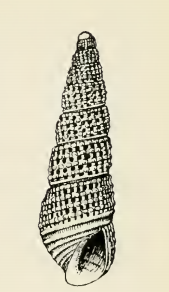
Orsotriaena medus is a butterfly found in south Asia, southeast Asia, and Australia. It is the only species in the genus Orsotriaena, first described by Hans Daniel Johan Wallengren in 1858.
Bog sedge is a vernacular name for any of the following plants:

Packera paupercula is a flowering plant species of the genus Packera and family Asteraceae, native to North America, where it is widespread across Canada and much of the United States. Its common names include balsam ragwort and balsam groundsel. It is a perennial herb that grows 1–3 feet tall. Its habitats include wet meadows, open woodlands, and rocky outcrops.

Acronicta vinnula, the delightful dagger moth, is a moth of the family Noctuidae. It is found from Nova Scotia to Florida, west to Texas, north to Wisconsin and Ontario.
Indopoa is a genus of Indian plants in the grass family. The only known species is Indopoa paupercula, native to Maharashtra and Karnataka in India.

Strigatella paupercula is a species of sea snail, a marine gastropod mollusk in the family Mitridae, the miters or miter snails.

Aspella is a genus of sea snails, marine gastropod mollusks in the family Muricidae, the murex snails or rock snails.

Polyptychus paupercula is a moth of the family Sphingidae. It is known from forests from Liberia to Uganda.

Odostomia paupercula is a species of sea snail, a marine gastropod mollusc in the family Pyramidellidae, the pyrams and their allies.

Agalinis paupercula, commonly known as the smallflower false foxglove, is a hemiparasitic annual plant native to the eastern parts of the United States and Canada. Found in open, moist areas, its purple flowers are borne on a 30-to-70-centimeter stem, and bloom in August and September. The species has often been treated as a variety of Agalinis purpurea, the purple false foxglove, and preliminary genetic evidence suggests that the two are, in fact, a single species.
Eilema paupercula is a moth of the subfamily Arctiinae found on Madagascar. It was described by Hervé de Toulgoët in 1965.
Rudenia paupercula is a species of moth of the family Tortricidae. It is found in Baja California, Mexico.
Bactriola is a genus of longhorn beetles of the subfamily Lamiinae, containing the following species:
Glypthaga is a genus of longhorn beetles of the subfamily Lamiinae, containing the following species:

Ageratina paupercula, called the Santa Rita snakeroot, is a North American species of shrubs or perennial herbs in the family Asteraceae. It is found only in the states of Arizona, Sonora, Chihuahua, Durango, Nayarit, and Jalisco.
Sophronica paupercula is a species of beetle in the family Cerambycidae. It was described by Holzschuh in 2006.
Bactriola paupercula is a species of beetle in the family Cerambycidae. It was described by Bates in 1885. It is known from Bolivia and Panama.
Glypthaga unicolor is a species of beetle in the family Cerambycidae. It was described by Martins and Galileo in 1990. It is known from Brazil.
Glypthaga vicina is a species of beetle in the family Cerambycidae. It was described by Martins and Galileo in 1990. It is known from Brazil.
Glypthaga xylina is a species of beetle in the family Cerambycidae. It was described by Henry Walter Bates in 1865. It is known from Brazil.








